1 billion people today live in unofficial settlements around the world. Slums, favelas, barrios or whatever you want to call them are the fastest growing urban zones of the world. These are massive areas dominated by people living off the grid with minimal infrastructure.
Mumbai, São Paulo, Shanghai, Mexico City, Cairo and many others are centers of informal economies and urbanism. Rem has been teaching studios exploring them - are they our future or past?
Discuss...
Lagos, Nigeria (with 13 million is the 3rd largest city in the world), and home to the best scam artists.
Nice photo, evilplatypus. It's a rare one that I had to think about for a little while.
I'm in DC almost every day, yet I'm not "infected" as you imply.
Washington has a serious sprawl problem, but the city itself is actually quite nice and less dense than most cities because of the building height restrictions.
I would er. Imagine those two properties are related?
In seriousness, this really plagued me while I was in India. People who havent been have no concept of what an unbelievable human catastrophe theyre heading toward. The scale of suffering in these places is simply beyond comprehension. The most helpless and terrifying thing is knowing a solution might never be found. I dont know if anything less than the most monumental human effort will even make a dent. Microloans are part of it, and I appreciate de soto's ideas, but you cant support a billion people weaving shawls and wire nicknacks for tourists. You have to defibrillate the entire local economy, and at some point youre going to need to produce real exports in marketable quantities. Its going to take the most massive rethinking of landuse for entire countries just to keep people alive while they try to crest the growth curve.
If they had the money, I would think the only logical course of action would be to start at the bottom, basic human needs. Start with water and sanitation, basic medical and education services. Then youve got to lance these things like an abscess. Find an economically integrated place for mass housing, transportation, just to relieve the pressure enough that those left behind could even think of internally developing. Theres no use bulldozing slums if theres nowhere else to live, and theres no use stuffing thousands of people in public housing if theres nowhere for them to work.
I know this is the old modernist part-line, but I have to say, having been to Chandigarh, there are certainly worse places in the world.
haven't been to the slums in rio (the story of rem's partner's murder sorta freaked me out over the idea)...but there is def a pattern emerging round the world.
i do live in a mega-city though...tokyo went from flattened hell hole to world economic power in less than a generation, and you can still see some of the squalor that came with that part of its history if you walk round enough...but somehow there are 33 million people in the area and things are almost working. i am not sure why it was possible here...political will on the part of both american and japanese govts to deal with things probably was a big help...and also a history of a certain kind of relationship between the poor and the wealthy. none of the crusading of the victorian age, but a big heaping of self-reliance and centralised state power (which seems anachronistic)...and not so much of the rich getting richer at the expense of the poor. very socialist country in some respects...
how the slums and favelas are going to improve is hard to imagine...the political systems in which they evolved are not generally set up to respond in a nice way, as far as i know...would love to hear that i am wrong on that though.
I once read a comment by Oscar Niemeyer about Rio's favelas, where he noted that part of the dilema in improving them is that with ameliorated sanitation, infrastructure, and safety, sooner or later they would face gentrification - given Rio's expensive real estate and huge density, the middle and upper classes will move into the favelas and edge out the poor, especially in those favelas on the hillsides with the gorgeous ocean views. I think he has a point; improved public safety and building quality could foreground the picturesque, human-scaled qualities of many slums (I know it sounds romantic, but you have to admit that most slums exhibit some similarities to the kind of organic growth of the pre-modern cities everyone loves). This could easily make them desirable alternatives to "well-planned' modern cities.
Niemeyer, ever the pessimistic communist, actually seemed to suggest that the best thing for slums, given this problem, would be to leave them more or less alone. So long as society possesses class disparity and capitalism, he implied, maybe there needs to be spaces that are undesirable to the bourgeoisie - as awful as they frequently are, at least slums make spaces in the city for people who can't otherwise afford it. I think Niemeyer is rather defeatist, and I certainly think there are several strategies to this problem that are still open to us, but I've sometimes wondered about the role of ugliness in the contemporary built environment in keeping conventional market forces away. I know, I know; most slums are not necessarily nurturing places to live in, and most people understandably don't want to live in an ugly house, even if it was purposefully built and competently serviceable. But in the face of gentrification and the ever-broadening reach of fashionable, expensive architecture, the little subversive in me imagines resistant ugliness as a kind of back-pocket strategy ready for deployment, should the moment ever arise...
...But apart from the aforementioned politicians and lobbyists, DC is actually quite nice.
Anyhow, informal economies and reactive, improvised environments are fascinating academic material but aren't well suited as a model for so-called first world development. Despite the current infatuation with flows of capital and whatnot, much of occidental culture (and economies) depend on systems of land tenure that would collapse with deregulation.
That said, I am a never to be homeowner in Los Angeles, so I wouldn't be totally opposed to an old fashioned peasant revolution.
THERES A GOOD BOOK "PLANET OF SLUMS" THATS PRETTY GOOD READ ON THIS FACINATING TOPIC. TALKS OF 3 HR. COMMUTES FROM GARBAGE DUMP CITIES AND THE INTL. FORCES THAT HELPED CREATE THESE MESSES.
The oldest european colonial city in the western hemisphere, Santo Domingo is now the largest city in the carribean. Under the rule of the dictator/washington stoog Trujillo, the population of SD was rather modest for most of the 20th C. Over the last 20 or so years, the population has exploded. Needless to say, there has been little planning or expansion of infrastructure to accomodate the new residents. The political situation got even more complex by the division of the city into 5 new administative districts.
On the banks of the Ozama River where the land is officially deliniated as an ecological reserve, the largest cluster of barrios and slums has emerged. The following images were taken during a boat excursion up the Ozama in January 2006 as part of our studio site visit.
i assume this post is in reference to the Nov. 13 New Yorker article "The Megacity: Decoding the Chaos of Lagos".
i think the last paragraph sums it up:
"There is an even darker possibility: that the world won't feel the weight of it much at all. The really disturbing thing about Lagos's pickers and venders is that their lives have essentially nothing to do with ours. They scavange an existence beyond the margins of macroeconomics. They are, in the harsh terms of globalizations, superfluous."
I was inspired by the NYer piece and wanted to throw my own .02$ into the ring (and expand some of the discussion about LA to the global stage now that Cornfields is over).
As architects/planners/'scapers/IntDesers/whatevers, we can either be part of the solution or part of the problem. I'd hope that our professions have more heart then just reacting to the latest typhoon, earthquake, tsunami, or whatever disaster of the week makes the front page. Cameron is doing great work with AFH, but the small scale interventions that he's behind are barely scratching the surface of engaging this alter ego of urbanism.
Hehe.. Koolhaas came here to talk to his Lagos project a couple of weeks ago, ended up losing his slides and then saying barely anything about Lagos at all :p
*bump* Due to site maintenance, I believe my original post was lost in Archinect server land :) – no biggie; so here is a re-write:
Treekiller – I agree; we really do need to focus on proactivness by looking at the solutions rather than focusing on the aftermath. I have to be honest that I am as guilty as anyone when it comes to responding to situations; a good example is my reaction to the Katrina disaster. I wanted to reach out and help in some way so I came up with a proposal to pair up mentors (architects) with mentees (students) to help rebuild New Orleans communities. Once I wrote the proposal, my plan was to take it to the AIA; but after reviewing the content with various advocates and stakeholders, I felt the best line of attack would be to start locally with a small proposal; Once the proposal got off the ground, my intention (and vision) was to submit it to a larger community and instill a more holistic approach of focusing on urban design as a whole rather than reacting to the devastation as we always do. Unfortunately, the proposal died with the local community.
So do you have any ideas on engaging arhitects/planners/'scapers/IntDesers to deal with urbanism on a larger scale than what Cameron is doing – where would we start??? I support this direction but I am lost and frustrated on how we engage the right people and get those folks to build an urbanism strategy / plan that everyone can stand behind. Thoughts?
hmmmm- that's why I started this thread. My intellectual efforts are mostly focused these days on sustainability issues of stormwater, energy use, plants, and infrastructure. Not a direct application to emergant urban conditions, but a method to engage my local conditions and improve life downstream. Most of the megacities that I've looked at are downstream.
(no need to *bump* when the post is still up on the first discussion page or two).
I guess I am just impatient when it comes to issues like these – I hear/read a lot of discussion but see little movement/progress/results on a global level. On the flip side, I am happy to see that there are people out there that are trying to make a difference at least at a local level.
This is a topic that is quite interesting to me and something that i am working on for me thesis this year. My site is in Mexico City and my approach is, sure there are conditions that are undesirable for you and I, but there are millions of people willing to live with these conditions. Rather than attempting to deal with their problems from a privledged, subjective, and distant position, is there a way to see what works well in these informal fringe settlements and incorporate it into and urban stategy that is focused on the future viability of the overall city? The ecological disaster of Mexico City is certainly something requiring attention, with its extreme air pollution and the quest for clean water which is causing the city to sink 3.5 ft a year, but the population is still growing by about 300,000 immigrants a year. How can you reconcile the two circumstances?
when I was in Brazil last may there was a project taking hold where people in the favelas were painting their houses on the hillside in bright colors. They was also a project going on where they where providing street lighting and recreational areas...I guess after a while someone figures out making life better makes the country better.
City Population |Definition Area |Population density
1 Mumbai, India 12,778,721 Municipal corporation 440(km²) | 29,042/km²
2 Karachi,Pakistan 11,507,254 City District 3,530(km²) | 3,458/km²
3 Delhi ,India 11,055,365 Municipal corporation 1,400(km²) |7,896/km²
4 São Paulo, Brazil 11,016,703 City proper 1,520(km²) | 7,247/km²
5 Shanghai, China 10,840,516 Core districts + inner suburbs 1,600(km²) | 6,775/km²
6 Moscow, Russia 10,375,688 City proper (excludes Zelenograd) 1,080(km²) | 9,607/km²
7 Seoul, South Korea 10,297,004 Special City 605.41(km²) | 17,008/km²
8 Istanbul, Turkey 10,124,000 City proper 1,970(km²) | 5,137/km²
9 Mexico City, Mexico 8,720,916 Federal District 1,550 | 5,626/km²
10 Tokyo, Japan 8,483,140 23 special wards area 620(km²) | 13,682/km²
11 Jakarta, Indonesia 8,407,479 Special capital district 660(km²) | 12,738/km²
12 New York City, United States 8,143,197 City Proper 780(km²) | 10,439/km²
13 Beijing, China 7,741,274 Core districts + inner suburbs 1,370(km²) | 5,650/km²
14 Tehran, Iran 7,609,638 City proper 760(km²) | 11,218/km²
15 London, United Kingdom 7,517,700 Greater London 1,580(km²) | 4,697/km²
16 Cairo, Egypt 7,438,376 Governorate 210(km²) | 35,420/km²
17 Bogotá, Colombia 7,321,831 Distrito Capital 1,590(km²) | 4,523/km²
18 Lagos, Nigeria 7,181,111 City core (old city proper) 330(km²) | 21,760/km²
19 Lima, Peru 6,872,766 30 districts 804.3(km²) | 8,545/km²
20 Hong Kong 6,752,001 Special Administrative Region 1092(km²) | 6,183/km²
21 Dhaka, Bangladesh 6,724,976 Urban area 200(km²) |30,403/km²
22 Bangkok, Thailand 6,542,751 Urban area 1,100(km²) | 6,311/km²
23 Lahore, Pakistan 6,192,853 City District 1,010(km²) |6,329/km²
24 Rio de Janeiro, Brazil 6,136,652 City proper 1,180(km²) | 5,200/km²
25 Baghdad, Iraq 5,556,562
26 Bengalooru, India 5,158,019 Municipal corporation 230(km²) | 22,426/km²
27 Wuhan, China 5,147,431 Urban area 400(km²) | 12,868/km²
28 Tianjin. China 5,083,657 Urban Area
29 Chongqing, China 4,865,499
30 Santiago, Chile 4,810,997
31 Saint Petersburg, Russia 4,661,219 City proper 1,439(km²) | 3,330/km²
32 Kolkata, India 4,651,322 Municipal corporation
33 Pune, India 4,485,000 Municipal Corporation 700(km²) | 6,407/km²
34 Singapore 4,408,220 Country 699(km²) |6,306/km²
35 Kinshasa, Democratic Republic of the Congo 4,385,264
36 Chennai, India 4,368,883 Municipal corporation
37 Shenyang, China 4,111,624
38 Guangzhou , China 4,056,025
39 Los Angeles. USA 3,844,829 City proper 1,290(km²) | 2,980/km²
40 Ahmedabad, India 3,796,043 Municipal corporation 190(km²) | 19,979/km²
41 Sydney, Australia 3,774,894 Urban area 1,690(km²) |2,234/km²
42 Busan,South Korea 3,657,840 223 dong 763.46(km²) | 4,791/km²
43 Alexandria, Egypt 3,693,412 Governorate 2,680(km²) | 1,378/km²
44 Hyderabad, India 3,619,856 Municipal corporation 170 (km²)| 21,293/km²
45 Yokohama, Japan 3,600,175 City proper 440(km²) | 8,182/km²
46 Ankara, Turkey 3,561,187 City proper 2,500(km²) |1,424/km²
47 Casablanca, Morocco 3,462,648
48 Ho Chi Minh City, Vietnam 3,407,129 City core (old city proper)
49 Berlin, Germany 3,405,250 State 892 (km²)| 3,818/km²
50 Madrid, Spain 3,155,359 Municipal Corporation 607(km²) | 5,198/km²
Thanks for the info tk – I was expecting different stats from the bottom forty (some higher and some lower) but esp. Sydney, Berlin and Madrid – expected them to be a little higher (no reason, just speculation).
Treekiller, nice table. I think, though, its missing border cities (cities which are divided between jurisdictions but which are still integral integrated cities), like Singapore-Johore Baharu-Bintang-Batam (10 million, not 4.4). San Diego-Tijuana-Tecate-Rosarito (5.5 million), Detroit-Windsor, complexes in Western Germany-Eastern France, Benelux, etc.
thas right...tokyo has 33 million if you count the suburbs in the metro area. city centre itself is mostly empty cuz property values got too high to use it for housing...
next up will be metropolitan/urban areas... I like this chart because it defines the entity. Would have never thought that Seoul is 223 dongs, but those wikis missed NYC being 5 boroughs...
'nother one for the statistic nerds, the world according to numbers
looking at this site's metro areas ranking: Toyko, Japan 31.2 million New York City - Philadelphia area, USA 30.1 million Mexico City, Mexico 21.5 million Seoul, South Korea 20.15 million Sao Paulo, Brazil 19.9 million Jakarta, Indonesia 18.2 million Osaka-Kobe-Kyoto, Japan 17.6 million New Delhi, India 17.36 million Mumbai, India (Bombay) 17.34 million Los Angeles, USA 16.7 million Cairo, Egypt 15.86 million Calcutta, India 14.3 million Manila, Philippines 14.1 million Shanghai, China 13.9 million Buenos Aires, Argentina 13.2 million Moscow, Russian Fed. 12.2 million
Last time I drove the NJ turnpike between NYC & Philly, there was a stretch near trenton where you certainly felt like you were not in a metro area... hmm, so does the NY metro area really stretch down to DC and reach up to Boston?
an alternate tidbit of fuel for this discussion: how rich are you?.
no matter how I enter my salary or household earnings, I'm stuck in the richest 1% of the world... and I don't feel that rich.
...Ain't you heard of the starving millions
Ain't you heard of conraception
Do you really wanna go with the sterilization
Take control of the population boom
It's in your living room
Keep a generation gap
Try wearing a cap...
I'm quite bored today, so I've been staring at this List of Metropolitan Areas by population for about 45 minutes, ever since somebody posted it on the Chicago-Olympic thread. It fascinates me....kind of like baseball statistics, except better because I can compare it to maps and start to visualize where the densest areas are, etc.
I'm also amazed to see how big some of these "metropolitan areas" are....for instance, at #4 on the population list, New York comes in at a whopping 6,720 square miles! Amazing.
Anyway, thought this was a quality thread and worth "necroing". *
*Meaning "to bring a thread back from the dead". Source: Apurimac.
oe, thanks for your concern about bombay. though agreed its a difficult place to live, it is much safer than most other megalopolises discussed here. Or well (i am assuming from your attitude that you're american) its much safer than Blacksburg, Virginia.
Much less crazy people on the street
bombay safer than blacksburg? Can't say, haven't been to either but it sounds like an interesting notion.
These "slums" fascinate me, especially the hill-towns in Rio and Hong Kong. I think one of the major social/economical problems that we are going to face in this century is rapid urbanization and the poverty that it seems to generate. It seems alot of people move from rural areas, where they were once productive, to cities to find work only to find there is little "official" work there, so they either become part of an underground economy or are forced to live in a perpetual state of poverty which affects all of us. I have no clue how we as architects, so long the pets of the rich, can begin to address this problem, which is obviously far more grave than designing art museums. I think while we cannot directly address this problem, as the root is political and economical, but we may be able to work towards alleviating the intense squalor these people have to live in.
the "underground" economy is technically called the informal economy and is responsible for most of the service industry within these cities. slum dwellers are often the people working in restaurants, driving taxis, washing clothes, caring for children, etc. many slum dwellers you would have no idea that they lived in slums if you met them on the street.
slums are not always miserable places to live. they are often built very close to city railways or large infrastructure often on some of the most valuable property in an urban area. they function as autonomous cities with schools, hospitals, and commerce within the slum. many slum dwellers would not want to leave the slum if presented with the option. the biggest problem that i've seen within slums is sanitation. there can be as few as one toilet per 1,000 residents. any notion of slum rehabilitation must start with sanitation.
there are many NGOs working within slums. the one i am most familiar with is SPARK working in slums in mumbai. i think architects' greatest opportunity to work within slums is to partner with existing NGOs. there is a great need for design in these places, but it has to be sensible and work with the slum dwellers to find solutions to the problems that exist within the slum. there is a huge social aspect to design that must not be ignored when working within these areas.
First thought: What a tired subject...I would want people/architects to seriously question their motives/POV before engaging in any kind of rhetoric on conditions of ¨slums¨ and the people that live in them. Personally I struggle with being a kid from the upper 1% of the world population trying to figure out what to do for those ¨poor poor people¨.
I've rarely seen anything but banal and superficial outpourings from either journo's or writers within and outside of architecture on the topic.
I suspect a lot of the valuabe literature/investigations arelocl to these communities and not likely to appear in a Western Sunday newspaper spread...
Koolhaas/Lagos book will be interesting, but from his presentation on the topic I doubt he will offer any ¨radical¨ solutions. It's more likely to fuel a series of copycat, second-rate academic follow-ups...Well-funded post-grads jetting off to the most fucked up piece of ¨bottom-up¨ architecture they can find so they can publish it with MIT Press and have a better looking CV. Yes, I'm a cynic.
MEMORY:
The kids in a Cochin (Kerala) slum I saw had bigger smiles on their faces than any pasty skinned, crisp eating, Coke sipping, PSP playing arrogant little teenager I have seen in any European Old Town.
MEMORY:
¨It's a good thing they're not organised...If they were, they'd run the place¨ - a friends comment to me on the Rio favelas during visit to Rio. NOTE: I never managed to go to a favela in Rio. Why? Cus I was shit scared. Yep. Sure, Rocinha has had a much hyped face lift that allows tourists to take a ¨guided¨ cab tour to the new ¨high street¨ where the locals fog them their 100% ghetto ware. And the tourists can go home with a snappy and a story that they visited a favela. NOT! And the problem is not getting in...You need to know someone, but the problem rather is GETTING OUT.
NOTE:
It was interesting that in Gaza, the people recently voted to have certain streets widened (so tat cars could enter). This was opposed by certain groups that feared it would be to easy for Isreal to drive in their tanks. This exact problems faces the Rio police, when they engage in one of their murderous ¨clean-up¨ missions: They enter with armoured vehicles, snipers, helicopers and whatnot but they can never take the place...At the end of the day they will retreat having killed a few dozen people (see Aug 2nd 2007).
The favelas are perhaps the true Modernist legacy of Rio's history. Maybe we should simply see them as proper and pure democratic cities, that simply can't exist with respect (on the grid) because capitalism does not allow them to. But they certainly exist as evidence of the possibility (and perhaps not a negative one) of how we could live without property laws...Did you know that no one is really clear on who actually OWNS the land of the favelas?
Also, consider that it's not just one mega slum...It's a highly distibuted urban form getting close to 1000 micro-slums in Rio alone.
MEMORY:
Picking up a book that was an INDEX of academic papers on Rio's favelas...600 and counting. I wonder how many of these really did the m any good.
Argh, someone Brazilian on these threads should give me a good bitch slapping about talking like this. I hope someone will.
I could go on...But let's not have more lists of ¨high-scores¨ for mega cities Bruce Mau bullshit.
it is about the people and dealing with real environmental problems - not favela voyeurism like rem/mike davis engage in. There are real issues and real solutions that some of us care about. A list only shows the magnitude of our world - so why doesn't more architectural academic time deal with the other 90%?
But it's a good thread jafidler.....I'd hate to let it be derailed by one comment.
Thanks for bumping this again barry, I was just reading Orhan's news post myself.
Most of these make sense and with India's population breaking a billion, it's easy to understand how it could have 3 cities in the top 10. But is it smart growth? I worry less about cities like Tokyo or New York or even Shanghai, because those are well-established metropolises (metropoli?) with governments that probably used to the issues involved with sustaining a massive population. But as Calcutta grows? Shamefully I do not know much about the demographics of this city but isn't it largely slums to begin with? How do you grow slums smartly? It's a scary thought....
it is a good thread and one that i've enjoyed reading and taking part in. roed, you weren't derailing anything, and it sounds like you have a unique perspective on this issue having visited a number of these places. my issue was just the sanctimonious tone of your post (and barry's follow-up about davis and rem). i believe there are all sorts of levels of engagement with these cities, from statistical to working on the ground. yes, fundamentally it is about people, but there are all sorts of methods of coming to a better understanding of the situation, and calling people stupid, even in jest, is not helpful.
Statistics is one thing...Whether Mexico City is 8 or 20 million or whether London is 7 million or 12 etc. etc. isn't...That's just pop.
The point is perhaps that it's not like these cities don't have planners or architects already that aren't clued in and working on these issues. Really, it becomes a problem of architecture quite high up the problem chain in my opinion. But maybe we should start thinking about an architecture that addresses corruption? Can we do that?
And sure these places need sanitation and whatnot, but I really wanted to turn the discussion on its head (and you, jafidler, were already hinting at this in your own post) where perhaps we do not see the "slum", the favela, as the problem but rather the rest of the city...Perhaps the favela actually proposes an attractive urban model, but as it is condemned to play an informal role (on many levels) its simply not taken serious. Basically, the biggest "fix" needed is in the perception we have of it - as a zone of trouble/violence/drugs/danger/chaos.
But this is only a micro representation of the macro problem under capitalism - and the CITY IS CAPITALISMS ULTIMATE MANIFESTATION - somebody will have to get the shit end of the stick.
So let me progress my rant: People do not need charity or NGOs per se. They just need to be treated and paid and respected equally.
the favela actually proposes an attractive urban model
that is rem's thesis...
it's not a romantic perception shift that's needed. its not about architecture, but about infrastructure. infrastructure is a basic human right - ie, clean water, sanitation, clean air, clean food, and a healthy environment. So if some know-it-all western ivy league brain can be the catalyst for these 'improvements' that the informal marketplace (and formal capitalism) has not provided, then everybody is a winner. yeah we can pay workers more (workers of the world unite!!!) and end illegal immigration, but the tragedy of the commons won't allow the underlaying infrastructure to be improved without interventions from higher up.
I don't care what the houses look like, or who paid off whom to move into a postage stamp on an unstable hillside. It is a failure of the governments to provide the services, not a failure of the poor to ignore the rules. its better late then never. Capitalism may be the cause, but it isn't always the solution.
Pedro's paper is interesting, but doesn't address how to improve the existing conditions. The 'slums' ain't going away - so give the people transit and clean water, then they can get to jobs and be healthy enough to earn a living wage.
megacities or?
1 billion people today live in unofficial settlements around the world. Slums, favelas, barrios or whatever you want to call them are the fastest growing urban zones of the world. These are massive areas dominated by people living off the grid with minimal infrastructure.





Mumbai, São Paulo, Shanghai, Mexico City, Cairo and many others are centers of informal economies and urbanism. Rem has been teaching studios exploring them - are they our future or past?
Discuss...
Lagos, Nigeria (with 13 million is the 3rd largest city in the world), and home to the best scam artists.
ITS THE BIGGEST ON THE PLANET
WHERE THE TALLEST BUILDINGS STAND
WITH THE HIGHEST POPULATION
AND WHERE NOTHINGS MADE BY HAND
THEY GOT THE LATEST THING IN TRAVEL
THAT GO AT THE FASTEST SPEED
WHERE EVERYTHING IS PLENTIFUL
THERE IS NO NEED FOR GREED
EVERYONE IS WONDERFUL
AND EVERYWHERE IS CLEAN
EVERYTHING IS POSSIBLE
IN MEGA CITY 3
MORE TELEVISION STATIONS
THAN IN MEGA ONE AND TWO
THE LARGEST CIVIC CENTRE
AND THE BIGGEST INDOOR ZOO
NO NEED FOR AGGRAVATION
THERES NO NEED FOR VIOLENT CRIME
WITH EVERYTHING THEY WANTED
AND THEY EVEN GET MORE TIME
EVERYONE IS WONDERFUL
AND EVERYWHERE IS CLEAN
EVERYTHING IS POSSIBLE
IN MEGA CITY 3
EVERYONE IS WONDERFUL
AND EVERYWHERE IS CLEAN
EVERYTHING IS POSSIBLE
IN MEGA CITY 3
EVERYONE IS WONDERFUL
AND EVERYWHERE IS CLEAN
EVERYTHING IS POSSIBLE
IN MEGA CITY 3
EVERYONE IS WONDERFUL
AND EVERYWHERE IS CLEAN
EVERYTHING IS POSSIBLE
IN MEGA CITY 3
EVERYONE IS WONDERFUL
AND EVERYWHERE IS CLEAN
EVERYTHING IS POSSIBLE
IN MEGA CITY 3
WHY DON'T YOU GO TODAY
GO TAKE A HOLIDAY
A MAN COULD LIVE FOREVER IN MEGA CITY 3
-Spizz
i hear you can get an infection just by walking down the street there
Nice photo, evilplatypus. It's a rare one that I had to think about for a little while.
I'm in DC almost every day, yet I'm not "infected" as you imply.
Washington has a serious sprawl problem, but the city itself is actually quite nice and less dense than most cities because of the building height restrictions.
I would er. Imagine those two properties are related?
In seriousness, this really plagued me while I was in India. People who havent been have no concept of what an unbelievable human catastrophe theyre heading toward. The scale of suffering in these places is simply beyond comprehension. The most helpless and terrifying thing is knowing a solution might never be found. I dont know if anything less than the most monumental human effort will even make a dent. Microloans are part of it, and I appreciate de soto's ideas, but you cant support a billion people weaving shawls and wire nicknacks for tourists. You have to defibrillate the entire local economy, and at some point youre going to need to produce real exports in marketable quantities. Its going to take the most massive rethinking of landuse for entire countries just to keep people alive while they try to crest the growth curve.
If they had the money, I would think the only logical course of action would be to start at the bottom, basic human needs. Start with water and sanitation, basic medical and education services. Then youve got to lance these things like an abscess. Find an economically integrated place for mass housing, transportation, just to relieve the pressure enough that those left behind could even think of internally developing. Theres no use bulldozing slums if theres nowhere else to live, and theres no use stuffing thousands of people in public housing if theres nowhere for them to work.
I know this is the old modernist part-line, but I have to say, having been to Chandigarh, there are certainly worse places in the world.
<party-line>
haven't been to the slums in rio (the story of rem's partner's murder sorta freaked me out over the idea)...but there is def a pattern emerging round the world.
i do live in a mega-city though...tokyo went from flattened hell hole to world economic power in less than a generation, and you can still see some of the squalor that came with that part of its history if you walk round enough...but somehow there are 33 million people in the area and things are almost working. i am not sure why it was possible here...political will on the part of both american and japanese govts to deal with things probably was a big help...and also a history of a certain kind of relationship between the poor and the wealthy. none of the crusading of the victorian age, but a big heaping of self-reliance and centralised state power (which seems anachronistic)...and not so much of the rich getting richer at the expense of the poor. very socialist country in some respects...
how the slums and favelas are going to improve is hard to imagine...the political systems in which they evolved are not generally set up to respond in a nice way, as far as i know...would love to hear that i am wrong on that though.
what does rem think?
I once read a comment by Oscar Niemeyer about Rio's favelas, where he noted that part of the dilema in improving them is that with ameliorated sanitation, infrastructure, and safety, sooner or later they would face gentrification - given Rio's expensive real estate and huge density, the middle and upper classes will move into the favelas and edge out the poor, especially in those favelas on the hillsides with the gorgeous ocean views. I think he has a point; improved public safety and building quality could foreground the picturesque, human-scaled qualities of many slums (I know it sounds romantic, but you have to admit that most slums exhibit some similarities to the kind of organic growth of the pre-modern cities everyone loves). This could easily make them desirable alternatives to "well-planned' modern cities.
Niemeyer, ever the pessimistic communist, actually seemed to suggest that the best thing for slums, given this problem, would be to leave them more or less alone. So long as society possesses class disparity and capitalism, he implied, maybe there needs to be spaces that are undesirable to the bourgeoisie - as awful as they frequently are, at least slums make spaces in the city for people who can't otherwise afford it. I think Niemeyer is rather defeatist, and I certainly think there are several strategies to this problem that are still open to us, but I've sometimes wondered about the role of ugliness in the contemporary built environment in keeping conventional market forces away. I know, I know; most slums are not necessarily nurturing places to live in, and most people understandably don't want to live in an ugly house, even if it was purposefully built and competently serviceable. But in the face of gentrification and the ever-broadening reach of fashionable, expensive architecture, the little subversive in me imagines resistant ugliness as a kind of back-pocket strategy ready for deployment, should the moment ever arise...
Well I was just implying that DC is a slum. It may be a clean slum but its a slum none the less. Full of bandits, gangsters and hooligans.
...But apart from the aforementioned politicians and lobbyists, DC is actually quite nice.
Anyhow, informal economies and reactive, improvised environments are fascinating academic material but aren't well suited as a model for so-called first world development. Despite the current infatuation with flows of capital and whatnot, much of occidental culture (and economies) depend on systems of land tenure that would collapse with deregulation.
That said, I am a never to be homeowner in Los Angeles, so I wouldn't be totally opposed to an old fashioned peasant revolution.
THERES A GOOD BOOK "PLANET OF SLUMS" THATS PRETTY GOOD READ ON THIS FACINATING TOPIC. TALKS OF 3 HR. COMMUTES FROM GARBAGE DUMP CITIES AND THE INTL. FORCES THAT HELPED CREATE THESE MESSES.
Next edition (part 1):
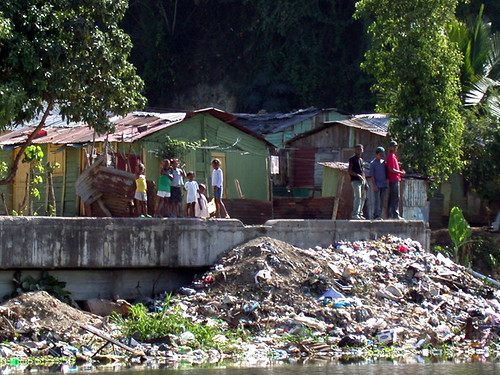
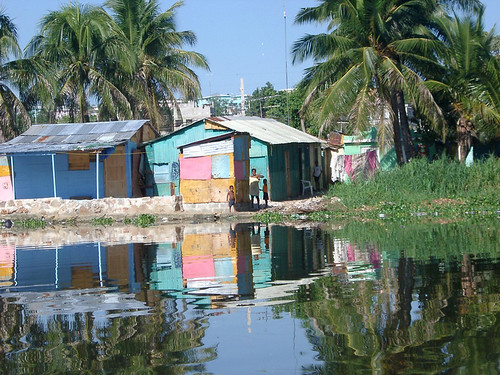

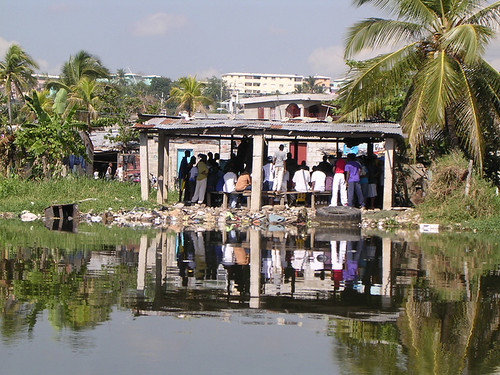

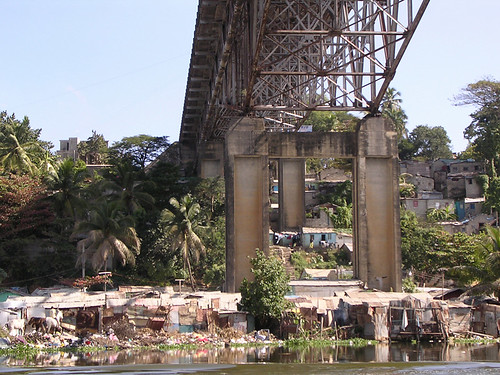
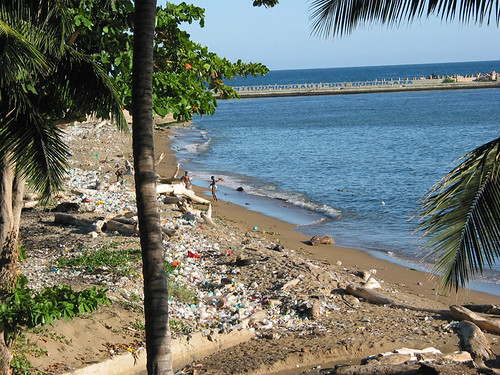
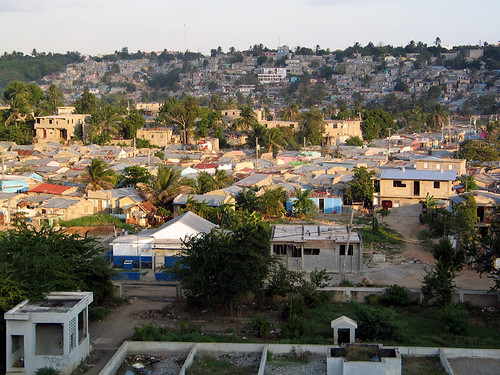
Santo Domingo, Dominican Republic
The oldest european colonial city in the western hemisphere, Santo Domingo is now the largest city in the carribean. Under the rule of the dictator/washington stoog Trujillo, the population of SD was rather modest for most of the 20th C. Over the last 20 or so years, the population has exploded. Needless to say, there has been little planning or expansion of infrastructure to accomodate the new residents. The political situation got even more complex by the division of the city into 5 new administative districts.
On the banks of the Ozama River where the land is officially deliniated as an ecological reserve, the largest cluster of barrios and slums has emerged. The following images were taken during a boat excursion up the Ozama in January 2006 as part of our studio site visit.
river bank improvement:
community bathroom:
pasture:
entertainment destination:
the local ferry:
how the other side crosses:
the beach at the mouth of the Ozama:
the barrio-city interface:
- part 2
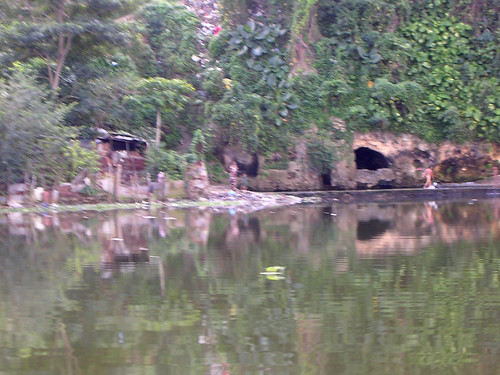
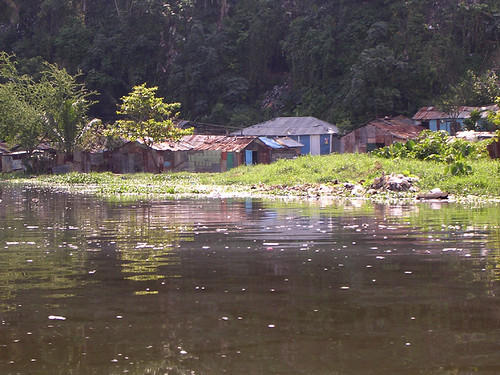
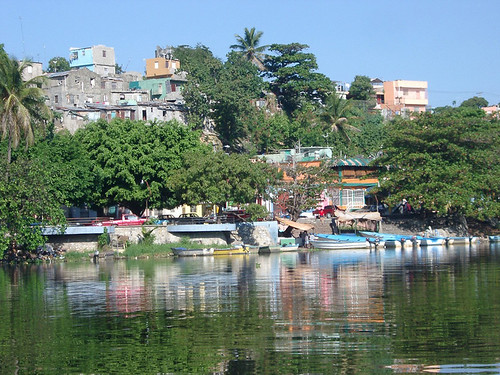
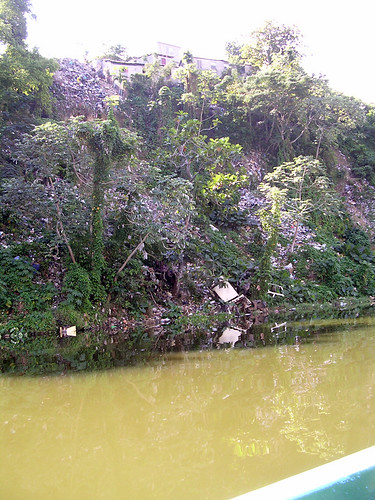
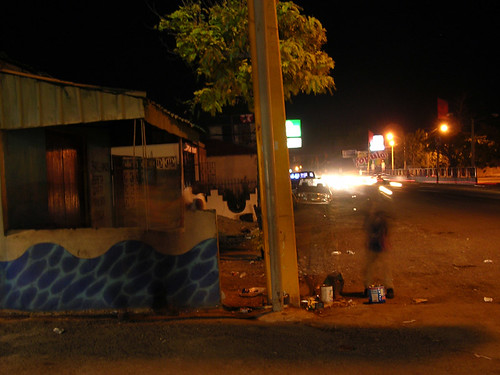
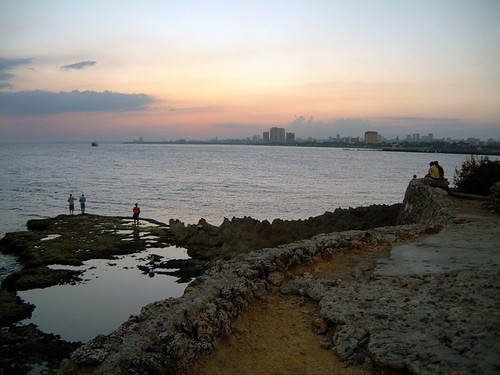
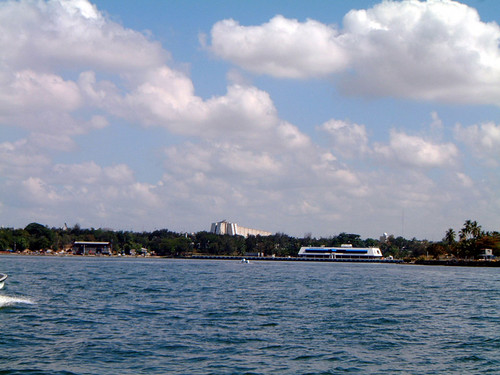
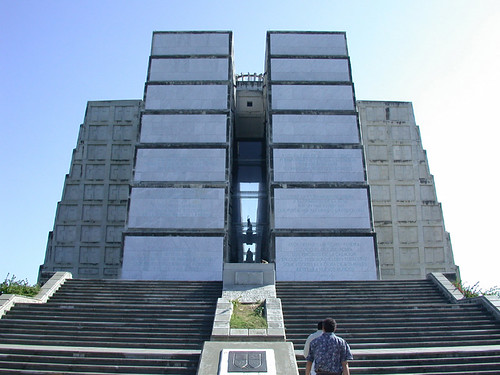
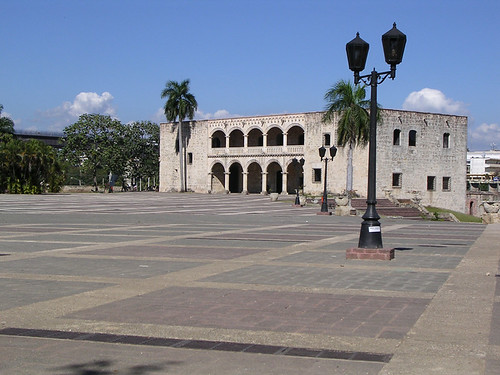
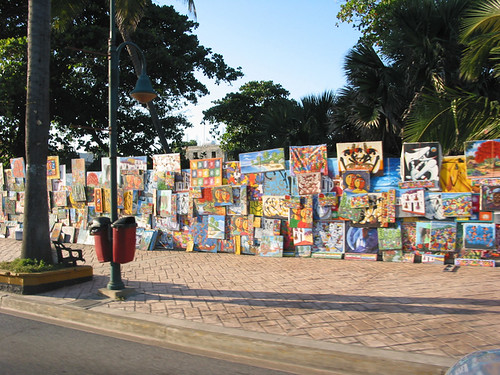

swimming hole:
i assume this post is in reference to the Nov. 13 New Yorker article "The Megacity: Decoding the Chaos of Lagos".
i think the last paragraph sums it up:
"There is an even darker possibility: that the world won't feel the weight of it much at all. The really disturbing thing about Lagos's pickers and venders is that their lives have essentially nothing to do with ours. They scavange an existence beyond the margins of macroeconomics. They are, in the harsh terms of globalizations, superfluous."
I was inspired by the NYer piece and wanted to throw my own .02$ into the ring (and expand some of the discussion about LA to the global stage now that Cornfields is over).
As architects/planners/'scapers/IntDesers/whatevers, we can either be part of the solution or part of the problem. I'd hope that our professions have more heart then just reacting to the latest typhoon, earthquake, tsunami, or whatever disaster of the week makes the front page. Cameron is doing great work with AFH, but the small scale interventions that he's behind are barely scratching the surface of engaging this alter ego of urbanism.
tK- citizen of the world
Hehe.. Koolhaas came here to talk to his Lagos project a couple of weeks ago, ended up losing his slides and then saying barely anything about Lagos at all :p
*bump* Due to site maintenance, I believe my original post was lost in Archinect server land :) – no biggie; so here is a re-write:
Treekiller – I agree; we really do need to focus on proactivness by looking at the solutions rather than focusing on the aftermath. I have to be honest that I am as guilty as anyone when it comes to responding to situations; a good example is my reaction to the Katrina disaster. I wanted to reach out and help in some way so I came up with a proposal to pair up mentors (architects) with mentees (students) to help rebuild New Orleans communities. Once I wrote the proposal, my plan was to take it to the AIA; but after reviewing the content with various advocates and stakeholders, I felt the best line of attack would be to start locally with a small proposal; Once the proposal got off the ground, my intention (and vision) was to submit it to a larger community and instill a more holistic approach of focusing on urban design as a whole rather than reacting to the devastation as we always do. Unfortunately, the proposal died with the local community.
So do you have any ideas on engaging arhitects/planners/'scapers/IntDesers to deal with urbanism on a larger scale than what Cameron is doing – where would we start??? I support this direction but I am lost and frustrated on how we engage the right people and get those folks to build an urbanism strategy / plan that everyone can stand behind. Thoughts?
hmmmm- that's why I started this thread. My intellectual efforts are mostly focused these days on sustainability issues of stormwater, energy use, plants, and infrastructure. Not a direct application to emergant urban conditions, but a method to engage my local conditions and improve life downstream. Most of the megacities that I've looked at are downstream.
(no need to *bump* when the post is still up on the first discussion page or two).
I guess I am just impatient when it comes to issues like these – I hear/read a lot of discussion but see little movement/progress/results on a global level. On the flip side, I am happy to see that there are people out there that are trying to make a difference at least at a local level.
Sorry for the premature bump :)
This is a topic that is quite interesting to me and something that i am working on for me thesis this year. My site is in Mexico City and my approach is, sure there are conditions that are undesirable for you and I, but there are millions of people willing to live with these conditions. Rather than attempting to deal with their problems from a privledged, subjective, and distant position, is there a way to see what works well in these informal fringe settlements and incorporate it into and urban stategy that is focused on the future viability of the overall city? The ecological disaster of Mexico City is certainly something requiring attention, with its extreme air pollution and the quest for clean water which is causing the city to sink 3.5 ft a year, but the population is still growing by about 300,000 immigrants a year. How can you reconcile the two circumstances?
ArT- please post some pics of Cuidad Mexico here!
regarding your thesis, floating cities may be the answer.
crap. how do i get that in the post?
follow the greyed out instructions below the post a response box.....
Alright, I'll try this again. Sorry for being such an inept beginner.

Also, there is a pretty interesting article I just came across here:
[url=http://subtopia.blogspot.com/2006/09/squatter-mimicry.html]link[url]
ArT- here you go:
link
try the preview button to test your links and images.
OK sorry about the link. C&P:






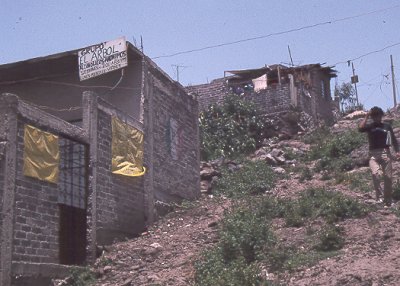
http://subtopia.blogspot.com/2006/09/squatter-mimicry.html
this is not a rendered image. I didn't believe it unitl i saw it.
this is the area of my site, Nezahualcoyotl.
more Neza.
What?
when I was in Brazil last may there was a project taking hold where people in the favelas were painting their houses on the hillside in bright colors. They was also a project going on where they where providing street lighting and recreational areas...I guess after a while someone figures out making life better makes the country better.
from Wikipedia
City Population |Definition Area |Population density
1 Mumbai, India 12,778,721 Municipal corporation 440(km²) | 29,042/km²
2 Karachi,Pakistan 11,507,254 City District 3,530(km²) | 3,458/km²
3 Delhi ,India 11,055,365 Municipal corporation 1,400(km²) |7,896/km²
4 São Paulo, Brazil 11,016,703 City proper 1,520(km²) | 7,247/km²
5 Shanghai, China 10,840,516 Core districts + inner suburbs 1,600(km²) | 6,775/km²
6 Moscow, Russia 10,375,688 City proper (excludes Zelenograd) 1,080(km²) | 9,607/km²
7 Seoul, South Korea 10,297,004 Special City 605.41(km²) | 17,008/km²
8 Istanbul, Turkey 10,124,000 City proper 1,970(km²) | 5,137/km²
9 Mexico City, Mexico 8,720,916 Federal District 1,550 | 5,626/km²
10 Tokyo, Japan 8,483,140 23 special wards area 620(km²) | 13,682/km²
11 Jakarta, Indonesia 8,407,479 Special capital district 660(km²) | 12,738/km²
12 New York City, United States 8,143,197 City Proper 780(km²) | 10,439/km²
13 Beijing, China 7,741,274 Core districts + inner suburbs 1,370(km²) | 5,650/km²
14 Tehran, Iran 7,609,638 City proper 760(km²) | 11,218/km²
15 London, United Kingdom 7,517,700 Greater London 1,580(km²) | 4,697/km²
16 Cairo, Egypt 7,438,376 Governorate 210(km²) | 35,420/km²
17 Bogotá, Colombia 7,321,831 Distrito Capital 1,590(km²) | 4,523/km²
18 Lagos, Nigeria 7,181,111 City core (old city proper) 330(km²) | 21,760/km²
19 Lima, Peru 6,872,766 30 districts 804.3(km²) | 8,545/km²
20 Hong Kong 6,752,001 Special Administrative Region 1092(km²) | 6,183/km²
21 Dhaka, Bangladesh 6,724,976 Urban area 200(km²) |30,403/km²
22 Bangkok, Thailand 6,542,751 Urban area 1,100(km²) | 6,311/km²
23 Lahore, Pakistan 6,192,853 City District 1,010(km²) |6,329/km²
24 Rio de Janeiro, Brazil 6,136,652 City proper 1,180(km²) | 5,200/km²
25 Baghdad, Iraq 5,556,562
26 Bengalooru, India 5,158,019 Municipal corporation 230(km²) | 22,426/km²
27 Wuhan, China 5,147,431 Urban area 400(km²) | 12,868/km²
28 Tianjin. China 5,083,657 Urban Area
29 Chongqing, China 4,865,499
30 Santiago, Chile 4,810,997
31 Saint Petersburg, Russia 4,661,219 City proper 1,439(km²) | 3,330/km²
32 Kolkata, India 4,651,322 Municipal corporation
33 Pune, India 4,485,000 Municipal Corporation 700(km²) | 6,407/km²
34 Singapore 4,408,220 Country 699(km²) |6,306/km²
35 Kinshasa, Democratic Republic of the Congo 4,385,264
36 Chennai, India 4,368,883 Municipal corporation
37 Shenyang, China 4,111,624
38 Guangzhou , China 4,056,025
39 Los Angeles. USA 3,844,829 City proper 1,290(km²) | 2,980/km²
40 Ahmedabad, India 3,796,043 Municipal corporation 190(km²) | 19,979/km²
41 Sydney, Australia 3,774,894 Urban area 1,690(km²) |2,234/km²
42 Busan,South Korea 3,657,840 223 dong 763.46(km²) | 4,791/km²
43 Alexandria, Egypt 3,693,412 Governorate 2,680(km²) | 1,378/km²
44 Hyderabad, India 3,619,856 Municipal corporation 170 (km²)| 21,293/km²
45 Yokohama, Japan 3,600,175 City proper 440(km²) | 8,182/km²
46 Ankara, Turkey 3,561,187 City proper 2,500(km²) |1,424/km²
47 Casablanca, Morocco 3,462,648
48 Ho Chi Minh City, Vietnam 3,407,129 City core (old city proper)
49 Berlin, Germany 3,405,250 State 892 (km²)| 3,818/km²
50 Madrid, Spain 3,155,359 Municipal Corporation 607(km²) | 5,198/km²
Thanks for the info tk – I was expecting different stats from the bottom forty (some higher and some lower) but esp. Sydney, Berlin and Madrid – expected them to be a little higher (no reason, just speculation).
Treekiller, nice table. I think, though, its missing border cities (cities which are divided between jurisdictions but which are still integral integrated cities), like Singapore-Johore Baharu-Bintang-Batam (10 million, not 4.4). San Diego-Tijuana-Tecate-Rosarito (5.5 million), Detroit-Windsor, complexes in Western Germany-Eastern France, Benelux, etc.
thas right...tokyo has 33 million if you count the suburbs in the metro area. city centre itself is mostly empty cuz property values got too high to use it for housing...
next up will be metropolitan/urban areas... I like this chart because it defines the entity. Would have never thought that Seoul is 223 dongs, but those wikis missed NYC being 5 boroughs...
yeah, Mexico City is about 20 million instead of 8. Anyway, I thought this was interesting:
http://www.frieze.com/feature_single.asp?f=1165
Treekiller, thanks for the preview heads up. I didn't think it would show the link.
'nother one for the statistic nerds, the world according to numbers
looking at this site's metro areas ranking:
Toyko, Japan 31.2 million
New York City - Philadelphia area, USA 30.1 million
Mexico City, Mexico 21.5 million
Seoul, South Korea 20.15 million
Sao Paulo, Brazil 19.9 million
Jakarta, Indonesia 18.2 million
Osaka-Kobe-Kyoto, Japan 17.6 million
New Delhi, India 17.36 million
Mumbai, India (Bombay) 17.34 million
Los Angeles, USA 16.7 million
Cairo, Egypt 15.86 million
Calcutta, India 14.3 million
Manila, Philippines 14.1 million
Shanghai, China 13.9 million
Buenos Aires, Argentina 13.2 million
Moscow, Russian Fed. 12.2 million
Last time I drove the NJ turnpike between NYC & Philly, there was a stretch near trenton where you certainly felt like you were not in a metro area... hmm, so does the NY metro area really stretch down to DC and reach up to Boston?
ahh - a more academic/thorough list is here.
an alternate tidbit of fuel for this discussion:
how rich are you?.
no matter how I enter my salary or household earnings, I'm stuck in the richest 1% of the world... and I don't feel that rich.
...Ain't you heard of the starving millions
Ain't you heard of conraception
Do you really wanna go with the sterilization
Take control of the population boom
It's in your living room
Keep a generation gap
Try wearing a cap...
I'm quite bored today, so I've been staring at this List of Metropolitan Areas by population for about 45 minutes, ever since somebody posted it on the Chicago-Olympic thread. It fascinates me....kind of like baseball statistics, except better because I can compare it to maps and start to visualize where the densest areas are, etc.
I'm also amazed to see how big some of these "metropolitan areas" are....for instance, at #4 on the population list, New York comes in at a whopping 6,720 square miles! Amazing.
Anyway, thought this was a quality thread and worth "necroing". *
*Meaning "to bring a thread back from the dead". Source: Apurimac.
One of my flickr contacts, Kayodic, made this photo essay about the life alongside the railways in Jakarta Indonesia: Jakarta underexposed
oe, thanks for your concern about bombay. though agreed its a difficult place to live, it is much safer than most other megalopolises discussed here. Or well (i am assuming from your attitude that you're american) its much safer than Blacksburg, Virginia.
Much less crazy people on the street
Treekiller, probably rem and his kool gang should try and explore the well developed slums that most western cities are
and If i may add to sameold's post...
more friendly,adjusting,cooperative and emphatic people on the street.
bombay safer than blacksburg? Can't say, haven't been to either but it sounds like an interesting notion.
These "slums" fascinate me, especially the hill-towns in Rio and Hong Kong. I think one of the major social/economical problems that we are going to face in this century is rapid urbanization and the poverty that it seems to generate. It seems alot of people move from rural areas, where they were once productive, to cities to find work only to find there is little "official" work there, so they either become part of an underground economy or are forced to live in a perpetual state of poverty which affects all of us. I have no clue how we as architects, so long the pets of the rich, can begin to address this problem, which is obviously far more grave than designing art museums. I think while we cannot directly address this problem, as the root is political and economical, but we may be able to work towards alleviating the intense squalor these people have to live in.
the "underground" economy is technically called the informal economy and is responsible for most of the service industry within these cities. slum dwellers are often the people working in restaurants, driving taxis, washing clothes, caring for children, etc. many slum dwellers you would have no idea that they lived in slums if you met them on the street.
slums are not always miserable places to live. they are often built very close to city railways or large infrastructure often on some of the most valuable property in an urban area. they function as autonomous cities with schools, hospitals, and commerce within the slum. many slum dwellers would not want to leave the slum if presented with the option. the biggest problem that i've seen within slums is sanitation. there can be as few as one toilet per 1,000 residents. any notion of slum rehabilitation must start with sanitation.
there are many NGOs working within slums. the one i am most familiar with is SPARK working in slums in mumbai. i think architects' greatest opportunity to work within slums is to partner with existing NGOs. there is a great need for design in these places, but it has to be sensible and work with the slum dwellers to find solutions to the problems that exist within the slum. there is a huge social aspect to design that must not be ignored when working within these areas.
*bump*
megacities of the future in forbes magazine (thanks orhan).
Tokyo - Projected Population in 2015: 35.5 million
Population in 2005: 35.2 million
Mumbai - Projected Population in 2015: 21.9 million
Population in 2005: 18.2 million
Mexico City - Projected Population in 2015: 21.6 million
Population in 2005: 19.4 million
Sao Paulo - Projected Population in 2015: 20.5 million
Population in 2005: 18.3 million
New York - Projected Population in 2015: 19.9 million
Population in 2005: 18.7 million
Delhi - Projected Population in 2015: 18.6 million
Population in 2005: 15 million
Shanghai - Projected Population in 2015: 17.2 million
Population in 2005: 14.5 million
Calcutta - Projected Population in 2015: 17 million
Population in 2005: 14.3 million
Dhaka - Projected Population in 2015: 15.2 million
Population in 2005: 12.4 million
Jakarta - Projected Population in 2015: 16.8 million
Population in 2005: 13.2 million
But I still want to know how can mike davis write a book on megacities and slums without even leaving los angeles?
First thought: What a tired subject...I would want people/architects to seriously question their motives/POV before engaging in any kind of rhetoric on conditions of ¨slums¨ and the people that live in them. Personally I struggle with being a kid from the upper 1% of the world population trying to figure out what to do for those ¨poor poor people¨.
I've rarely seen anything but banal and superficial outpourings from either journo's or writers within and outside of architecture on the topic.
I suspect a lot of the valuabe literature/investigations arelocl to these communities and not likely to appear in a Western Sunday newspaper spread...
Koolhaas/Lagos book will be interesting, but from his presentation on the topic I doubt he will offer any ¨radical¨ solutions. It's more likely to fuel a series of copycat, second-rate academic follow-ups...Well-funded post-grads jetting off to the most fucked up piece of ¨bottom-up¨ architecture they can find so they can publish it with MIT Press and have a better looking CV. Yes, I'm a cynic.
MEMORY:
The kids in a Cochin (Kerala) slum I saw had bigger smiles on their faces than any pasty skinned, crisp eating, Coke sipping, PSP playing arrogant little teenager I have seen in any European Old Town.
MEMORY:
¨It's a good thing they're not organised...If they were, they'd run the place¨ - a friends comment to me on the Rio favelas during visit to Rio. NOTE: I never managed to go to a favela in Rio. Why? Cus I was shit scared. Yep. Sure, Rocinha has had a much hyped face lift that allows tourists to take a ¨guided¨ cab tour to the new ¨high street¨ where the locals fog them their 100% ghetto ware. And the tourists can go home with a snappy and a story that they visited a favela. NOT! And the problem is not getting in...You need to know someone, but the problem rather is GETTING OUT.
NOTE:
It was interesting that in Gaza, the people recently voted to have certain streets widened (so tat cars could enter). This was opposed by certain groups that feared it would be to easy for Isreal to drive in their tanks. This exact problems faces the Rio police, when they engage in one of their murderous ¨clean-up¨ missions: They enter with armoured vehicles, snipers, helicopers and whatnot but they can never take the place...At the end of the day they will retreat having killed a few dozen people (see Aug 2nd 2007).
The favelas are perhaps the true Modernist legacy of Rio's history. Maybe we should simply see them as proper and pure democratic cities, that simply can't exist with respect (on the grid) because capitalism does not allow them to. But they certainly exist as evidence of the possibility (and perhaps not a negative one) of how we could live without property laws...Did you know that no one is really clear on who actually OWNS the land of the favelas?
Also, consider that it's not just one mega slum...It's a highly distibuted urban form getting close to 1000 micro-slums in Rio alone.
MEMORY:
Picking up a book that was an INDEX of academic papers on Rio's favelas...600 and counting. I wonder how many of these really did the m any good.
Argh, someone Brazilian on these threads should give me a good bitch slapping about talking like this. I hope someone will.
I could go on...But let's not have more lists of ¨high-scores¨ for mega cities Bruce Mau bullshit.
It's about the people stupid.
it is about the people and dealing with real environmental problems - not favela voyeurism like rem/mike davis engage in. There are real issues and real solutions that some of us care about. A list only shows the magnitude of our world - so why doesn't more architectural academic time deal with the other 90%?
megacities talk at greenbuild - via multihousing news
whip out your slum cred, boys and girls. looks like there's a face off.
with comments like these i hope this thread sinks back into the depths.
But it's a good thread jafidler.....I'd hate to let it be derailed by one comment.
Thanks for bumping this again barry, I was just reading Orhan's news post myself.
Most of these make sense and with India's population breaking a billion, it's easy to understand how it could have 3 cities in the top 10. But is it smart growth? I worry less about cities like Tokyo or New York or even Shanghai, because those are well-established metropolises (metropoli?) with governments that probably used to the issues involved with sustaining a massive population. But as Calcutta grows? Shamefully I do not know much about the demographics of this city but isn't it largely slums to begin with? How do you grow slums smartly? It's a scary thought....
Excuse me, but how was I derailing anything...? And "Slum cred"...?
Please explain.
Oh, and I stand corrected: It's the economy stupid and how it's not working.
it is a good thread and one that i've enjoyed reading and taking part in. roed, you weren't derailing anything, and it sounds like you have a unique perspective on this issue having visited a number of these places. my issue was just the sanctimonious tone of your post (and barry's follow-up about davis and rem). i believe there are all sorts of levels of engagement with these cities, from statistical to working on the ground. yes, fundamentally it is about people, but there are all sorts of methods of coming to a better understanding of the situation, and calling people stupid, even in jest, is not helpful.
Ah, I see. But I was playing with this quote:
http://en.wikipedia.org/wiki/It's_the_economy,_stupid
Statistics is one thing...Whether Mexico City is 8 or 20 million or whether London is 7 million or 12 etc. etc. isn't...That's just pop.
The point is perhaps that it's not like these cities don't have planners or architects already that aren't clued in and working on these issues. Really, it becomes a problem of architecture quite high up the problem chain in my opinion. But maybe we should start thinking about an architecture that addresses corruption? Can we do that?
And sure these places need sanitation and whatnot, but I really wanted to turn the discussion on its head (and you, jafidler, were already hinting at this in your own post) where perhaps we do not see the "slum", the favela, as the problem but rather the rest of the city...Perhaps the favela actually proposes an attractive urban model, but as it is condemned to play an informal role (on many levels) its simply not taken serious. Basically, the biggest "fix" needed is in the perception we have of it - as a zone of trouble/violence/drugs/danger/chaos.
But this is only a micro representation of the macro problem under capitalism - and the CITY IS CAPITALISMS ULTIMATE MANIFESTATION - somebody will have to get the shit end of the stick.
So let me progress my rant: People do not need charity or NGOs per se. They just need to be treated and paid and respected equally.
I also wanted to introduce you to Pedro Abramo - here's an old-ish paper:
http://66.102.9.104/search?q=cache:uBo_c7rut60J:www.jm.u-psud.fr/~adis/rubriques/p/prox/i2-1.pdf+caleidoscopic+city+pedro+abramo&hl=en&ct=clnk&cd=1&gl=uk
that is rem's thesis...
it's not a romantic perception shift that's needed. its not about architecture, but about infrastructure. infrastructure is a basic human right - ie, clean water, sanitation, clean air, clean food, and a healthy environment. So if some know-it-all western ivy league brain can be the catalyst for these 'improvements' that the informal marketplace (and formal capitalism) has not provided, then everybody is a winner. yeah we can pay workers more (workers of the world unite!!!) and end illegal immigration, but the tragedy of the commons won't allow the underlaying infrastructure to be improved without interventions from higher up.
I don't care what the houses look like, or who paid off whom to move into a postage stamp on an unstable hillside. It is a failure of the governments to provide the services, not a failure of the poor to ignore the rules. its better late then never. Capitalism may be the cause, but it isn't always the solution.
Pedro's paper is interesting, but doesn't address how to improve the existing conditions. The 'slums' ain't going away - so give the people transit and clean water, then they can get to jobs and be healthy enough to earn a living wage.
Block this user
Are you sure you want to block this user and hide all related comments throughout the site?
Archinect
This is your first comment on Archinect. Your comment will be visible once approved.